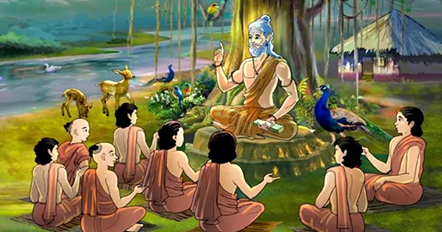The Vedic Age marks one of the most formative periods in Indian history, spanning roughly from 1500 BCE to 600 BCE. This era, characterized by the composition of the Vedas—the oldest sacred texts of Hinduism—laid the groundwork for Indian society’s spiritual, cultural, and social evolution. Though not a "revolution" in the conventional sense, the Vedic Age transformed Indian civilization in profound ways. Understanding the key developments and societal changes during this period is invaluable for IAS aspirants as it deepens historical knowledge essential for exams and current affairs.
The Rigveda, composed during the early Vedic period, is one of the world's oldest religious texts. Studying such ancient records not only gives insights into historical religious beliefs but also strengthens one's knowledge base for competitive exams. Maluka IAS Academy provides a deep dive into these historical texts as part of its GS Foundation course, essential for IAS and PCS preparations.
Key Highlights of the Vedic Age
1. Early and Later Vedic Periods
The Vedic Age is divided into two main periods: the Early Vedic Period (Rigvedic) and the Later Vedic Period. The Early Vedic Period was marked by semi-nomadic pastoral societies, while the Later Vedic Period saw more settled agricultural communities and the development of complex social hierarchies.
2. Religious Beliefs and Texts
The Vedas: Four Vedas—Rigveda, Samaveda, Yajurveda, and Atharvaveda—were composed during this time. They include hymns, rituals, and philosophical insights that formed the basis of Vedic religion.
Upanishads: Toward the end of the Vedic period, the Upanishads emerged, focusing on philosophy, metaphysics, and concepts like Brahman (universal soul) and Atman (individual soul), which are still foundational to Hindu philosophy.
3. Social and Political Structure
Varna System: During the Later Vedic Period, society was divided into four main varnas—Brahmins, Kshatriyas, Vaishyas, and Shudras—which became the basis for social order in ancient India.
Janapadas: Small tribal states, or Janapadas, formed as people settled into agricultural communities, giving rise to more organized governance structures.
4. Economic Life
Agriculture: The Later Vedic Period saw the transition from a primarily pastoral economy to one based on agriculture, with crops like barley, wheat, and rice being cultivated.
Trade and Barter: Economic exchanges primarily occurred through barter, with some trade expanding to neighboring regions. Cowherds and farmers became influential in this era as they controlled essential economic resources.
5. Education and Language
Oral Tradition: Knowledge was passed down orally, with a strong emphasis on memorization and recitation. The language of the Vedas, Sanskrit, is one of the oldest languages still studied today.
Gurukul System: Education happened in gurukuls (residential schools) where students lived with their teachers and studied a wide range of subjects, including astronomy, mathematics, and philosophy.
6. Legacy of the Vedic Age
The legacy of the Vedic Age endures in India's social and cultural practices. The age-old traditions and philosophical teachings continue to shape India's spiritual identity. This period also influenced later social structures, religious thought, and cultural development in the Indian subcontinent.

-1721391937657.png)


